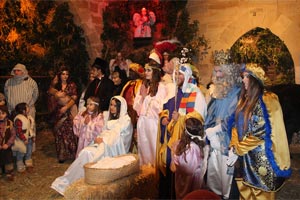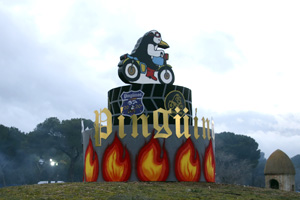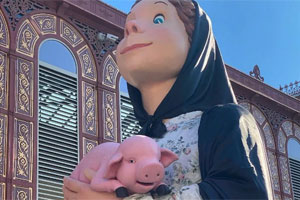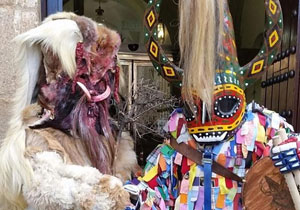The Mystery of Obanos
The Mystery of Obanos
The Mystery of Obanos is a theatrical representation that recreates a medieval story related to the Camino de Santiago, set in the Middle Ages. The plot revolves around the legend of San Guillén and Santa Felicia, which has endured over time thanks to oral tradition. The Mystery begins by narrating the discovery of the tomb of the apostle James in the year 813, depicting the supposed pilgrimages to Compostela and the dialogues between fictional and historical characters, as well as their return.
During the second half of July, the town of Obanos celebrates a festival that recreates this medieval legend associated with the Camino de Santiago. During this celebration, the townspeople stage a large-scale theatrical performance that fills the streets with banners, carriages, swords, shields, and costumes that transport us back to the medieval era.
The historical representation of the Mystery of Obanos is based on the martyrdom of Santa Felicia and the penance of San Guillén, a story that originated in the 14th century and has been passed down from generation to generation. Since 1965, this performance has taken place, standing out for its quality in terms of acting, costumes, and its connection to the Camino de Santiago. It is held during the week of July 25th (St. James's Day), every two years (in even-numbered years), in the Plaza de los Fueros of Obanos. The same representation is carried out for eight consecutive days.
The Plaza de los Fueros serves as the main stage for the performance. Part of the plaza's architecture, such as the arch and the old inn, was specifically built to be used as set pieces in the play. Between 300 and 400 extras participate in this performance, with the majority of them being residents of Obanos, while professional or amateur actors join the cast to play the main characters. It has been recognized as a Festival of National Tourist Interest since 2001.
Script and Legend
The Mystery of Obanos is a theatrical representation that recreates the medieval history of the Camino de Santiago, set in the Middle Ages. The plot revolves around the legend of San Guillén and Santa Felicia, which has endured over time thanks to oral tradition. The Mystery begins by narrating the discovery of the tomb of the apostle James in the year 813, depicting the supposed pilgrimages to Compostela and the dialogues between fictional and historical characters, as well as their return.
The story describes the pilgrimage of Princess Felicia of Aquitaine, who decides to renounce her life in the palace and live in the lordship of Amocáin in Navarra, dedicating her life to God as an anonymous servant. Her brother Guillén, upon realizing her choice, sets out in search of her. Unable to accept Felicia's renunciation of her social status, in a fit of anger, Guillén kills her instead of allowing her to live as a peasant. The representation of the Mystery is based on the legend, describing how Guillén stabs her in the chest with a Moorish dagger.
The legend is divided into two parallel stories. After committing fratricide, Guillén, advised by a monk, repents and embarks on his own pilgrimage to Compostela. Upon his return, he finds solace by dedicating his life to God as a hermit in the hermitage of Arnotegui in Obanos, Navarra. On the other hand, Felicia is considered a martyr and is buried in the church of the lordship of Amocáin. According to the legend, her tomb blossoms with a white carnation, interpreted as a miracle. Felicia's body is placed in an oak chest but later disappears and is found in the countryside. It is placed on a mule, guided by God, and the mule carries the body to the church of San Pablo in Labiano, Navarra. Felicia's supposedly incorrupt body is preserved in that church and venerated as that of a saint.
The Mystery of Obanos primarily focuses on Guillén's conversion, from a murderer to a hermit and saint. The character of the Elder, a priest, accompanies him in this transformation and urges him to travel to Compostela, repent, and forgive himself in order to find God's forgiveness in the hermitage of the Virgin of Arnotegui.
The second parallel story, the one of Felicia after her death, is told secondarily in the Mystery through a blind man and his companion, who narrate the legend to the people of Obanos during a pilgrimage.
Costumes
The collection of medieval costumes for the Mystery of Obanos consists of replicas created between 1965 and 1977. These outfits, along with a variety of carriages, armor, swords, banners, and horse harnesses, are housed in the building of the Mystery of Obanos Foundation, which is managed by the Brotherhood of Hermits of Arnotegui.
Initially, the costumes were designed by Francis Bartolozzi and made by Mari and Carmen Lozano, complemented by the ensemble from the Cunas Institution, belonging to Father Carmelo, a Dominican from Pamplona. Later, local seamstresses such as Clara Vélaz and Mª Luisa Ulzurrun from Obanos took charge of their production, particularly the caps.
In 1997, Mª Luz Vidart revised the costumes, and in 1999 and 2000, a group of people carried out important conservation work. Leatherworker Mariano Vélez was responsible for the leather garments and horse harnesses, while Feliciano Vélez inventoried them in 1998.
The collection of medieval costumes for the Mystery of Obanos has incalculable artistic value, which extends beyond its economic worth. It is an invaluable display of medieval art and tradition.
Origin and History of the Mystery of Obanos
The Mystery of Obanos, also known as the Mystery of San Guillén and Santa Felicia, is a historical reconstruction based on a beautiful legend of the Camino de Santiago. Passed down orally from generation to generation, this legend gave rise to a theatrical spectacle in the 1960s.
The priest of Obanos, Don Santos Beguiristáin, was the main driving force behind this representation. In 1962, the initial text titled "Del martirio de Santa Felicia y la penitencia de San Guillén" (The Martyrdom of Santa Felicia and the Penance of San Guillén) was read on the eve of the feast of San Guillermo. The reading was performed by the children of Obanos around a bonfire in the town square. The attendance was numerous, as the residents were encouraged to come "well-fed and without hurry."
The success of this first popular representation led to the creation of a text in Alexandrine verse that collected the medieval legend and added traditions and characters from the Camino de Santiago. The play was first staged in August 1965 and continued to be performed annually until 1977, with over a hundred performances and an audience of 130,000 people.
During these years, the Mystery of Obanos received support from the Provincial Council of Navarra and the Ministry of Information and Tourism, becoming part of the "Festivals of Spain." Additionally, the Mystery of Obanos received the extraordinary National Prize "Misterio de Elche."
After several years of interruption, in 1993, the Mystery of Obanos Foundation and the Brotherhood of Hermits of Arnotegui organized a new performance of the play as part of the Festivals of Navarra. This representation was repeated in 1999, consolidating the show thanks to the effort and collaboration of the residents of Obanos, who are the true protagonists of this cultural event. Since then, the play has been performed in subsequent years.
Over the years, the "Mystery of Obanos" has received several awards, earning national and international recognition. Numerous actors and directors have left their mark on this representation, contributing to the success and reputation of this event starring the people of Obanos.
What to See in Obanos
In Obanos, a charming village in the region of Navarra, Spain, there are several interesting places to visit. Here are some of them:
- Church of San Juan Bautista: This 13th-century Gothic church is one of the main attractions in Obanos. Its impressive architecture and beautiful artistic details make it worth exploring.
- Hermitage of Arnotegui: Located on the outskirts of Obanos, this hermitage is a place of great religious importance. It is believed to have been built in the 11th century and houses an image of the Virgin Mary. Additionally, it offers spectacular panoramic views of the surroundings.
- Cueva de los Demonios: This cave is mentioned in the legend of the Mystery of Obanos. Although it is not possible to enter the cave, it is worth visiting and exploring its surroundings to capture the mysterious atmosphere that surrounds it.
- Plaza de los Fueros: The heart of Obanos is its main square, where various bars, restaurants, and shops can be found. It is a perfect place to relax, enjoy the local cuisine, and observe the daily life of the village.
- Town Hall: Located in the town square, this 17th-century building stands out for its beautiful facade and traditional architecture. It is a representative example of the civil architecture of the region.
- Hiking Routes: Obanos is surrounded by beautiful natural landscapes. There are several hiking routes that start from the village and offer the opportunity to enjoy nature, explore the surroundings, and appreciate panoramic views.
These are just some of the attractions that Obanos has to offer. While strolling through its cobbled streets and immersing yourself in its medieval charm, visitors can discover more fascinating corners and delve into the rich history and culture of this charming Navarrese village.
What to Eat in Obanos
In Obanos, you can enjoy the delicious cuisine of Navarra. Here are some typical dishes and products that you shouldn't miss when visiting Obanos:
- Chistorra: A traditional sausage from the region, similar to a chorizo, made with marinated pork meat and spices. It is usually grilled and served as an appetizer or accompaniment.
- Pochas a la navarra: Pochas are tender and creamy white beans. In Navarrese cuisine, they are prepared with a sofrito of onion, garlic, bell pepper, and tomato, and are often combined with chorizo, bacon, or blood sausage.
- Lamb al chilindrón: A flagship dish of Navarrese cuisine. The lamb is cooked with a sauce made from tomato, red bell pepper, onion, and spices, resulting in a flavorful and comforting dish.
- Stuffed Piquillo Peppers: Piquillo peppers are a small and sweet variety of red pepper. In Obanos, they are stuffed with different fillings such as cod, meat, or seafood, and served as tapas or a main course.
- Roncal Cheese: A sheep's milk cheese with protected designation of origin, typical of the Roncal region in Navarra. It has an intense flavor and firm texture, perfect for enjoying with a good wine.
- Cider: Navarra is known for its cider production. Try the natural cider, refreshing and slightly acidic, ideal for accompanying food or enjoying at a local cider house.
In addition to these typical dishes, make sure to try the pintxos, small portions of food served on slices of bread, which are a tradition in the region. You can find a variety of delicious pintxos in the bars and restaurants of Obanos.
With its rich culinary tradition, Obanos offers an authentic and flavorful gastronomic experience. Don't hesitate to explore the local restaurants and let yourself be surprised by the flavors of the region.






